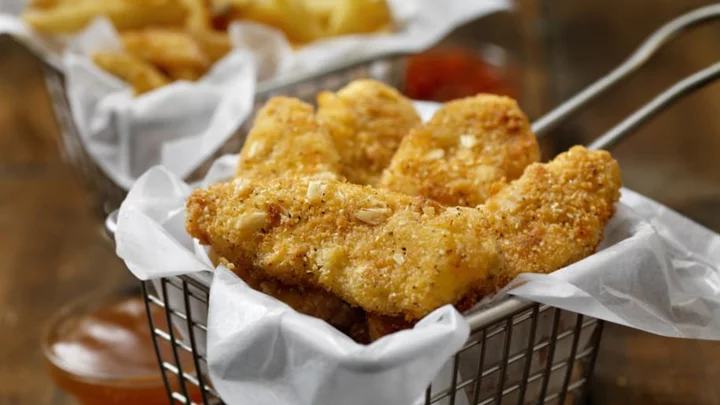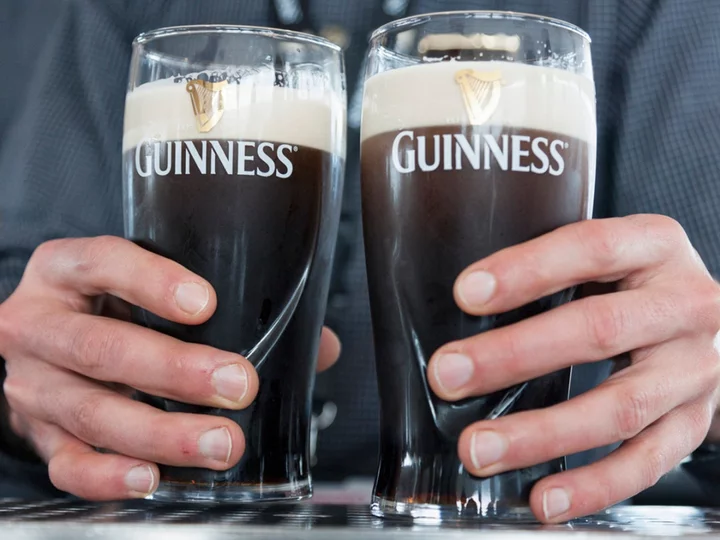
Gemma Atkinson slams trolls who called her ‘fat and unfit’ just three weeks after giving birth
Gemma Atkinson has hit back at trolls who called her “fat and unfit” just three weeks after giving birth to her second child. The Hollyoaks actor, 38, who welcomed son Thiago with Strictly professional Gorka Marquez, revealed she had been branded “fat and lazy” by trolls after her mum pushed her son’s pram back from a doctor’s appointment. Gemma, who had a C-section with son Thiago only last month, said: “I didn’t want to overdo it. “I’ve had a message saying how lazy I was letting my mum push the pram. I got another saying ‘you used to be fit and you’re still fat’.”
2023-08-11 23:58

Menswear has made women feel confident for centuries, but will the gendered separation ever cease to exist?
I remember the day I realised the embodiment of my persona was a long-sleeve ironed shirt with only the collar close-lipped. Initially, I gravitated toward the crisp button-down for function, as my former workplace tended to emit heaps of chilly air, but a spontaneous feeling compelled me to button the top, leaving the rest of the shirt open. It may have been, in part, my obsession with wanting to define my look outside of popular construction or how this new silhouette framed my figure. Regardless, the androgynous piece of clothing left me feeling more confident than ever before. A clothing rack full of these formal tops sits perpendicular to my bed now, and I wear them strategically closed with almost every outfit. I couldn’t tell you exactly what it is about them that makes me feel alluring and powerful, but my style hasn’t been the same since. Now more than ever, women are setting aside archival forms of womenswear for the structure of men’s clothing, assuming their most confident, authentic selves. Mini denim shorts, bodycon dresses, and micro skirts are being swapped for baggy jorts and boxers. Individuals are donning contrasting proportions, taking risks, and exuding self-assurance in items that have historically been deemed representative of masculine codes in Western fashion. In doing so, women are diminishing the gap between gendered collections. According to Hazel Clark, professor of fashion studies at Parsons School of Design, women initiated the crossover between menswear and womenswear in the early 19th century when they started working in coal mines and riding horses. A working-class of women deliberately assumed the male dress code, whether business or activity related, because womenswear constricted their necessary movement with tight bodices and corded petticoats. Here, function and ability took precedent over society’s expectation of femininity as more opted to dirty a pair of trousers instead of their voluptuous gowns. Heading into the Second World War and the 20th century, the design gap minimised further when women’s roles in society advanced. In the 1940s, men were forced to leave their factory jobs for war, leaving their female counterparts to fill their positions. For women to be respected in the workplace, they mirrored the male look and wore the classic pantsuit. Francesca Granata, professor of fashion theory and history at Parsons, identified the “power suit of the 1980s” as “a classic instance of women trying to access men’s power in the workplace by wearing an outfit which imitated menswear and with wife shoulders: the ideal male physique.” She noted: “Yet the wide-shouldered suit jacket was often rendered appropriately feminine by being paired with a skirt.” With this came an influx of women wearing these masculine codes outside of the workplace. Though my grey dress pants from the men’s section of a closet sale were welcomed into my weekly rotation almost immediately, it took a lot of courage and self-assurance back then for women to wear similar pairs, just like it did for them to wear miniskirts when both styles were socially unacceptable. The initial need for “businesswear” transformed into desired style even if it meant a woman could be labeled as “inappropriate” or be refused at the door of an establishment. Looks from men turned to public disapproval, but that didn’t stop the progression of women dressing in menswear at all. “Although baggy clothing has been acceptable for men for quite some time, especially in the US, unlike older appropriation of menswear which were often adapted to be more skintight or revealing or somewhat rendered ‘feminine’ baggy clothes question the old dictum that women’s bodies should be on display for the male gaze,” Professor Granata remarked. In other words, this “sense of power dressing” left the confines of the office environment alongside any lingering thought to the heteronormative gaze. Fast forward to the early 21st century, when the groundwork for this fashion fusion had been laid in terms of utility and preference. As society began to understand sexuality and gender fluidity, non-gendered collections became increasingly popular. Designers became more proactive about creating androgynous clothing that didn’t need to be separated into the two typical identifiers: women and men. “Fashion must get to a point where we don’t have to talk about gender,” designer and creative director of Loewe Jonathan Anderson wrote in Amelia Anderson’s “What We Can Do Better” in 2021, nine years after he introduced the first transgender collection for his eponymous brand. “Fashion can be a way to experiment with character or to work out your identity, and I believe that clothes can have a protective role on a more emotional level.” Anderson’s obsession with how queer individuals dressed contributed to his perception that fashion can be used to “break the rules”. To him, clothing is a marker of individuality and subculture, which is what motivates him to create designs for people to express themselves free from outdated norms. Between boxy, textured T-shirts, bouncy blouses, and tailored high-waisted pants, Anderson’s worked to incorporate rival style cues even in his gender-specific collections. “Clothing is full of paradoxes, but ultimately it can empower us - and in a world that has historically taken power away from queer people, that can be vital,” he proclaimed. “In a world that often expects certain things for certain people when it comes to clothes - where society wants men, say, to wear some things, and women to wear others - I sometimes question why I do menswear and womenswear shows. But for me, it’s not about classifying people, it’s about using these categories as ideas - ideas to borrow from.” As designers helped bridge the gap, celebrities like Hailey Bieber and Bella Hadid have been seen being more experimental in campaigns for big name brands as well as in their personal street style. The 26-year-old Rhode Skin founder has been a recognised ambassador for the French fashion house, Yves-Saint Laurent, a company which has irrevocably impacted womenswear since their 1966 creation of a menswear-motivated tuxedo for women called “Le Smoking.” Both Bieber and Hadid blend feminine and masculine codes in everyday wear, leading the craze for oversized jean shorts and lengthy vintage sportswear paired with dainty ballet flats and platform boots. Other brands, such as Uniqlo and Thom Browne, design collections labelled and distributed as menswear and womenswear, but the items are still being bought and worn interchangeably. “It’s hard to explain,” Marissa Petteruti, senior menswear designer at Rag & Bone, tells The Independent when asked why she feels more assured in men’s clothing over feminine-labelled pieces. “I’ve always just felt more comfortable in, you know, oversized men’s shirts and pants. I kind of always have gravitated toward men’s fashion. I remember when I was a kid, my parents used to tell me: ‘You have to wear a skirt one day a week.’ I never saw why I couldn’t wear whatever I wanted. So maybe part of it became going against what my parents wanted me to do.” Petteruti has cultivated a closet full of suit pants, designer shirts, and vintage bomber jackets in pursuit of the perfect capsule wardrobe and collection of exclusive ready-to-wear. Ever since she attended the Parsons School of Design, pressure and expectation were absent from her style. Here, Petteruti was drawn to the serenity of menswear, and she appreciated the simplicity of its form more than women’s clothing. Her eyes wandered to streetwear brands such as Supreme and Hood-by-Air because the concept of a lux T-shirt intrigued her, and oversized pieces were pleasing. When she started at Rag & Bone, she learned that men’s tailoring was more extensive, but even so, the trends were ephemeral - meaning the pieces were inherently timeless. Womenswear detailing such as peplum cuts, scallop or lace trimming, floral embellishments, and sheer fabrics tend to cycle through seasonal collections more frequently than the stylistic choices and material preferences within menswear. The classic button-down may be presented in a specific range of colours depending on whether it’s fall or spring, but the shape and design stay the same. In other words, womenswear is more likely to follow suit with trends. Industry leaders and A-listers embracing a more avant-garde mindset in ready-to-wear and street style begs the question of whether brands will ever officially scrap the formal separation of womenswear and menswear. “Why do they have to be called ‘men’s clothing’? Just ‘cause you put the buttons on one side of the shirt and the fly on one side of the shirt and the reverse. It’s, it’s silly to me,” Petteruti agreed when asked if she thought the division was necessary. “I mean, the interesting thing about fashion now is at any given moment, it’s so diverse. We don’t all wear the same things to be in fashion. If we wanted to be in fashion, I mean, regardless of our sort of age or gender, you know, they’re like lots of different choices we can make, depending on the kind of the group we associate with or who we follow,” Clark explained. But Clark doesn’t believe concrete separation is on the horizon, due to the sizing and proportional differences between a man versus a woman. “Men’s and women’s bodies are different. You know, I mean, that’s part of it. Size and physique will prevent womenswear and menswear from being entirely infused with one another,” she proclaimed. Petteruti would argue that there’s potential. Already, she’s seen Rag & Bone mix more feminine codes into their menswear designs with varying fabrics and silhouettes. Being that inspiration is often plucked from the demand and visibility of others who motivate obsessions, the runway no longer dictates style fads. This means it may be expensive on the backend for companies, but we could see collections move away from the label if consumers want more androgynous, unisex pieces. As for Granata, she interprets the division of womenswear and menswear as already having been “tenuous,” which is exactly why women found themselves gravitating toward masculine codes to begin with. Read More How hip-hop went from being shunned by big business to multimillion-dollar collabs Dior celebrates 5 years as designer in gender-fluid Paris men's show Womenswear leads the way as Ted Baker sales soar
2023-08-11 23:58

Katharine McPhee reveals she and husband David Foster suffered a ‘horrible family tragedy’
Katharine McPhee has revealed that she and husband David Foster have suffered a “horrible family tragedy”. The singer, 39, shared a statement to Instagram on 11 August to announce that she’ll be missing the rest of her husband’s tour in Asia, where she’s been performing as a guest, due to a family emergency. Although she didn’t specify what the tragedy was, she wrote that she’ll be heading home to be with her loved ones, while implying that her husband will still be doing the shows this weekend. “Dearest Jakarta fans, it’s with heavy heart I announce I have to miss our final two shows of our Asian run,” she wrote. “David and I have had a horrible tragedy in our family and at least one of us needs to get back home to our family.” She concluded: “Please know how sorry I am and how much I wish to return someday and perform for you all. Love, Katharine.” Many friends and fans of the couple took to the comments of McPhee’s post to send her kind messages amid the family tragedy. “Sending my love and prayers for your family,” Masked Singer judge Nicole Scherzinger wrote, while Linda Thompson added: “Sending you and David love, & hoping that everything is okay.” “Sending you loads of love. I’m thinking of you guys,” Amanda Kloots also wrote. Foster, 73, is still set to play at the Sentul International Convention Centre in Jakarta, Indonesia, on 11 August and 12 August, according to his official website. He will then be on a hiatus from his tour, before returning to the stage on 1 November in Warren, Michigan. The Independent has contacted a representative for McPhee and Foster for comment. Foster and McPhee made their official debut as a couple in 2018, before officially tying the knot the next year. They welcomed their first child, Rennie, in February 2021. Since then, they have continued to post about their son on social media, hinting that he also has a musical side. In June, Foster shared a video on Instagram of Rennie playing the drums, alongside the caption: “PROGRESS!! Two years three months.” During an interview with Entertainment Tonight in October, Foster acknowledged that although his youngest child has developed an interest in drumming, it’s still soon to tell if he’ll become a musician like his parents. “You know when you look at somebody like Andre Agassi and Steffi Graf, their kids are very talented... but they’re not tennis players, so we don’t know,” he said “He’s so young.” McPhee also agreed, adding: “It makes sense that he’d be musical, but we’re not really sure. He’s certainly obsessed with the drums! Or imaginary drums, for that matter.” Read More Katharine McPhee reveals whether she and David Foster want more children David Foster opens up about raising a toddler at age 73 Katharine McPhee defends husband David Foster after backlash over postpartum body comment Gemma Atkinson slams trolls who called her ‘fat’ just three weeks after giving birth Mother diagnosed with cystic fibrosis, anorexia and incurable cancer 7 ways for parents and carers to ease back-to-school worries
2023-08-11 23:53

A Guide to Argentina’s Many Exchange Rates
Argentina’s government has created a tangle of rules about who can access dollars and for what, spawning a
2023-08-11 23:25

1,500-year-old Teotihuacan village found in Mexico City
Archaeologists have uncovered a 1,500-year-old Teotihuacan village in Mexico City, complete with large concentrations of ceramics and three human burials, Mexico's National Institute of History and Anthropology has announced.
2023-08-11 22:56

Celebrity hair, makeup and nail stylists: How the Hollywood strikes have affected glam squads
A world of hair, makeup and manicurists have been idled by the Hollywood strikes at a time when they were still rebuilding from the covid shutdowns
2023-08-11 22:25

Chicken Tenders vs. Chicken Fingers: What's the Difference?
All fried chicken tenders qualify as fingers, but not all chicken fingers are tenders.
2023-08-11 22:17

DiCaprio-Backed Film Says Key Beef Supplier to the US Has a Dirty Secret
Nicaragua’s beef industry is under fresh scrutiny with a documentary backed by actor Leonardo DiCaprio, which claims that
2023-08-11 21:15

Investigation for manslaughter opens after fire at French home for disabled adults killed 11
A Paris prosecutor has opened a preliminary judicial investigation for unvoluntary manslaughter aggravated by breach of safety rules after a fire left 11 dead at a vacation home housing adults with disabilities in eastern France
2023-08-11 21:15

Mother diagnosed with cystic fibrosis, anorexia and incurable cancer says she ‘doesn’t feel afraid of dying any more’
A mother who was diagnosed with cystic fibrosis (CF) just days before her 30th birthday and later told she has myeloma – an incurable type of blood cancer – said she has “taught (herself) a whole new script for death” and, rather than feeling afraid, she feels “empowered” by what she has overcome. Ellie Allman, 42, who lives in Hadleigh, Suffolk, with her husband Steve, 44, a charity consultant, and son Harvey, 13, used to work as a specialist adviser for vulnerable young people but she had to retire, aged 35, after being diagnosed with CF aged 29. CF is an inherited condition that causes sticky mucus to build up in the lungs and digestive system, and while Ellie did not “feel anything initially” when she received her diagnosis, she “struggled mentally” later on and ended up developing anorexia, as she felt she had “no control over anything”. “I was off work, I was frustrated, I was angry, my body didn’t feel right CF-wise – I had no energy, I couldn’t do what I wanted,” Ellie told PA Real Life. “I was spending my days weighing everything I ate and just constantly doing the maths. “It seems ridiculous now, but it made so much sense at the time to that very determined person who was just clinging on to any form of normal life.” After becoming eligible to take Kaftrio in June 2021, a medication which significantly improves lung function, she noticed a vast improvement in her health. However, in less than a year, Ellie “randomly” became very unwell, and this led to the devastating news she has incurable cancer. After this, she underwent four months of chemotherapy alongside immunotherapy, followed by a stem cell transplant to replace the damaged blood cells with healthy ones in March 2023, and then a further two months of consolidation chemotherapy which included immunotherapy. She lost her hair, felt “exhausted” and anxious, and experienced pain “worse than labour contractions” from the “harvest of (her) stem cells” before the transplant, but she knew the pain would not last forever – and she said the support she has received from her husband, son, doctors, consultants and the charity, Ending Life’s Taboo, has been invaluable. She is now in remission and undergoing maintenance chemotherapy, and while she has experienced feelings of anger and resentment, she knows she can handle anything that her health throws at her. “I’ve taught myself a whole new script for death; I find it difficult to live with failing health, but I don’t feel afraid of dying any more,” she said. “We don’t get a choice, that’s just how it goes, but I think having the right people around you is so important. “I think it’s really natural when you’re young, or when you’re scared, to unintentionally isolate yourself or become withdrawn, and that has never ever worked for me. “I have to work hard not to lose myself within these diagnoses, and I have to remind myself that I’m still the person I was before my diagnosis.” During her childhood, Ellie developed whooping cough “in succession” – a bacterial infection of the lungs and breathing tubes – along with other chest infections and bouts of flu, but she was otherwise fit and healthy and used to run, swim, and was even a sports captain at school. She remembers certain periods of her life where she felt extremely fatigued and achy, but since her mother preferred alternative and natural medicines, Ellie rarely visited the doctor – and given she had “coughed (her) entire life”, she was “dismissive” of her symptoms. Later on, during her pregnancy, Ellie developed repeated chest infections, experienced difficulties with her speech, and could not clear her throat, but it was not until after she gave birth to her son Harvey, now 13, in 2010 that she underwent further testing. In February 2011, just days before her 30th birthday, it was confirmed she has cystic fibrosis – and, at first, she said she was “not willing to make room for CF in (her) life”. “You’ve lived your whole life not ill and then suddenly there’s this label,” Ellie said. “I didn’t feel anything initially, but I struggled with it later on, mentally.” According to the charity Cystic Fibrosis Trust, CF can be diagnosed during a new-born screening, which is carried out as part of the heel-prick test that all babies in the UK receive, but since this was only introduced nationally in 2007, this was not available for Ellie. Moreover, Ellie’s rare genotype made her CF even more difficult to diagnose. She underwent treatment in the form of intravenous (IV) antibiotics and physiotherapy sessions and noticed an improvement in her health, but when she started experiencing difficulties with her digestion – caused by a build-up of thick mucus – she started to feel “really frustrated with the world”. The side effects of the prescribed drugs also meant she could not conceive again – and while she is extremely grateful for her family, this had a “massive” impact on Ellie at the time. Ellie was then told she needed to take the medication Creon with food, which aids digestion, except for with fruits and vegetables, and this led to her developing anorexia in 2016. She said her head would “scream at her” but she could not “free (herself)” from negative thoughts that would body-shame her. “I had no control over anything, it was the perfect storm in a way; the perfect circumstances for me to use that as a control mechanism,” she said. Ellie became very weak after her “dramatic weight loss” of more than four-and-a-half stone, but after realising she needed to prioritise her health and time with her family, she underwent treatment and therapy to “reframe” her negative thoughts, so they were no longer a “dominant” force in her life. In June 2021, Ellie started taking Kaftrio, and she described it as “a miracle drug”, but approximately 11 months later, she began experiencing a “burning pain in (her) chest”. This led to the heart-breaking news in July 2022 that she has myeloma – a type of blood cancer, which is incurable – and the pain caused by treatments was unimaginable at times. She said: “Since Kaftrio thins the mucus, the high-dose chemo just ripped through the mucus in my throat, so I couldn’t swallow; the pain was insane. “My throat was blistered and ulcerated, so I couldn’t eat and I was put on to a feeding tube. “But I knew I had to get through it because if I stay in remission for two years, I could have a second transplant in future.” Ellie is now in remission and is undergoing maintenance chemotherapy, which she said “feels like a breeze in comparison”, and she is continuing to take Kaftrio, meaning the symptoms of her CF have “massively reduced” and she can enjoy the “simple things in life again”. She likes going on dog walks, meeting friends for a drink, and spending time with her “favourite people”, as that “makes everything else feel better” – and looking back now, she feels “empowered” that she has handled her CF, anorexia, cancer diagnosis, and treatments. While myeloma is incurable and Ellie has had some “existential thoughts”, she said processing what may happen in life has been “freeing” and she has always held on to hope. She has applied to become a magistrate and hopes another “miracle drug” like Kaftrio may become available during her lifetime to treat the cancer. She added: “Even in the most testing of times, every time I have found something positive to focus on or something to hope for and that has kept me going.” Ellie’s cancer is not linked to CF. To find out more information, visit: www.cysticfibrosis.org.uk/what-is-cystic-fibrosis/how-does-cystic-fibrosis-affect-the-body/cystic-fibrosis-complications/cancer Read More Dancer who has Tourette’s tics says Lewis Capaldi’s Glastonbury performance left her ‘speechless’ ‘Long Covid has taken away my ability to eat food or urinate - I don’t recognise myself anymore’ How to lower your blood sugar levels, as new research reveals heart disease link Groundbreaking cystic fibrosis drug made seven-year-old girl feel better ‘within hours’
2023-08-11 20:20

Where to find the best Guinness in London – and how to spot a bad one
Finding a decent pint of Guinness in London can all too often be a disappointing quest, from sour or bitter to poorly poured pints in plastic cups with bubbly heads. Some even say London is where Guinness goes to die. For those who feel they should at least enjoy drinking the pint they’ve paid ludicrous prices for, here’s a small, non-exhaustive and open-ended list of London pubs where you’re more or less guaranteed a scrumptious pint of what my friends and I call Guinny Jones. I’d like to add a disclaimer that I’m not an expert – though I am a quarter Irish and have taken the Guinness factory tour in Dublin – I just really, really like a good pint. So, I spoke to Ian Ryan, who runs an Instagram account dedicated to the capital’s crimes against the black stuff (@shitlondonguinness) and though he isn’t exactly short on blasphemous submissions, he’s also got a lot of insight into what makes a good pint and where to find it. Plus, Ian has a book coming out in October, A Beautiful Pint: One man’s search for the perfect pint of Guinness - he cares about the cause. Before we get to the pubs, here’s what we’re looking for in a pint. Texture: it should have a texture that withstands the “tilt test”, if you tip your glass slightly to the side and the head starts dripping down the side, it’s too watery. It should rise just above the edge of the glass in an oh-so-satisfying manner. Taste: Guinness has a malty sweetness and bitter hoppines, but it shouldn’t be too bitter, nor should it be sour. It should be rich and creamy, with slight aromas of coffee. If it tastes metallic, run for the hills. Head: a good pint of Guinness needs that signature creamy head. Ideally, it’ll be domed and around three-quarters of an inch. This is essential for balance and flavour. Also, if the head is littered with bubbles, it means it hasn’t been properly aerated and will almost definitely taste bad. Pour: according to Guinness Storehouse it should, of course, be in a Guinness or milk stout glass – it’s just wrong drinking out of a Stella or Beavertown. It should then be poured at a 45-degree angle up to the harp and then left to settle for at least a minute, but up to two if possible. It’s finished by topping up with the glass held straight. Red flags: according to Ryan, any sort of bubbles in the head are a big no-no. “Also, if you walk into a pub and no one is drinking Guinness, it could be a sign of bad things to come…” The Auld Shillelagh, 105 Stoke Newington Church Street, London, N16 0UD This Irish pub is most die-hard Guinness fan’s favourite London establishment, Ryan included. It looks tiny and unassuming from the outside but its narrow interior stretches far back into a surprisingly spacious garden. They have live music, great craic and, of course, perfect pints of Guinness. The best thing about the Shillay is that it doesn’t try too hard, which means it ends up absolutely nailing the pub formula. The Irish Times even named it the “most authentic Irish pub in the world outside Ireland”. If that doesn’t convince you, I don’t know what will. The Globe, 20 Morning Lane, London, E9 6NA A pub where you can enjoy Spoons prices without Spoons guilt, The Globe is a local’s pub through and through, but they’re also incredibly welcoming to newcomers. They’ve got live sports, pool, darts, karaoke, live music and pints of Guinness that pass the test at around the £4 mark, for zone 2, that’s practically unheard of. The Coach and Horses, 42 Wellington Street, London, WC2E 7BD Not far from Covent Garden piazza, The Coach and Horses is just far enough off the beaten track to not be inundated as most pubs in central are. This one-room Irish pub was once voted as the best Guinness in Britain by The Irish Post, plus they also sell hot roast beef sandwiches. Gibney’s London, 70 City Road, London, EC1Y 2BJ Staying open until 2am on a Friday, Gibney’s is an Irish pub based in the heart of Shoreditch. Upstairs they have “inventive small plates, Irish meats cooked over the open flame, fresh seafood and more from chef Richard Corrigan”, while downstairs they have Shit London Guinness-approved pints. The Cock Tavern, 23 Phoenix Road, London, NW1 1HB An unpretentious pub that prides itself on not being trendy, The Cock Tavern is a delight for both locals and tourists due to its proximity to Euston. Described by one reviewer as an “oasis of humour, personality and character” in the big city and endorsed by SLG, this rough-and-ready establishment knows how to pour a pint and provide good times. The Sheephaven Bay, 2 Mornington Street, London, NW1 7QD An “Irish bar with a conservatory, beer garden and no less than seven plasma screens for showing sports”, The Sheephaven Bay is easily the best Guinness in Camden. Lively atmosphere and friendly staff, what’s not to like? The Kenton Pub, 38 Kenton Road, London, E9 5BA Most of the pubs listed have unsurprisingly been of the Irish variety, so to throw a curve ball into the mix is the Kenton, a Norwegian pub in Hackney. There’s loads of cosy nooks and crannies, occasional DJs on a Saturday and the fantastic staff all pride themselves on pouring a proper pint. I asked general manager Morgan Ryan about what the secret to serving great Guinness is: “There’s not really a trick to it if you’ve ever poured a pint. Don’t buy old kegs, don’t store them badly and don’t have dirty ass lines.” Read More Marina O’Loughlin is wrong – there’s joy in solo dining Budget Bites: Three recipes to keep food bills down before pay day Meal plan: Romesco chicken and other recipes to fall in love with The chef who hated food as a child Who knew a simple flan could be so well-travelled? Midweek comfort food: Singaporean curry sauce and rice
2023-08-11 19:17

How the Maui Wildfires Became So Destructive, So Fast
At least 55 people are dead and hundreds of homes incinerated after tail winds from a hurricane stoked
2023-08-11 18:20
